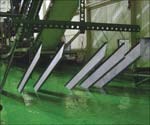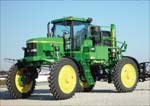Green with Envy
The John Deere Des Moines Works in Ankeny, IA is thriving, thanks to a combination of state-of-the-art technology and an inventive management philosophy…
Ask a farmer, forestry worker or even the guy down the street mowing his lawn what the name "John Deere" means to them, and they are likely to respond with one of four answers—integrity, quality, innovation or commitment.
It should come as no surprise then, that these are the foundations of Deere & Company, the corporation behind John Deere products. With four manufacturing divisions—agricultural equipment, commercial and consumer equipment, construction and forestry equipment and John Deere power systems—Deere & Company does business in more than 160 countries and employs more than 46,000 people worldwide.
Welcome! You’ve unlocked premium content.
Each day, 1,300 of those people report to work at the massive 450+ acre campus (featuring more than 2.8 million sq ft of production space) at John Deere Des Moines Works in Ankeny, Iowa.
Unlike many John Deere facilities, which manufacture only a single type of equipment, the Des Moines Works produces four different products for the company's agricultural equipment division—cotton pickers, sprayers, tillage equipment and grain drills. The variety enables the facility to stay busy year around. (As the seasonal demand for some equipment types begins to dwindle, it begins to pick up in another area.)
But at the same time, that variety can pose some unique, sometimes complicated challenges for the paint shop. "We work with four different design groups and four different manufacturing groups," says Kathy Harmon, materials engineering manager. "We think about design (for paintability) for four different products. We might be able to run all products through a single paint system, but there are very specific considerations for each one."
It's Not Easy Being Green
It's hard to imagine any other brand more closely associated with a color than John Deere is with its famous leafy green hue. Just how closely interlinked are the name and the color? Well, for one, Valspar—the coating company that manufactures the paint that John Deere uses in its spray painting operations—markets the color commercially as "John Deere Green." It has even become the title of a song by Country Music artist Joe Diffie. In the song, a boy named Billy Bob professes his love to a girl named Charlene by painting her name in John Deere Green in three-foot high letters on the town water tower. Now that's true love.
Needless to say, the value that the finish lends to John Deere products is almost incalculable. "A lot of people will treat their John Deere equipment better than their car," says Harmon. "We'll have some customers scrutinize every inch of their sprayer looking for the slightest knick or scratch before making a purchase." Harmon notes that in addition to pride, resale value is also a consideration for many John Deere customers.
Aesthetics aside, the finishes found on John Deere products also play an important functional role. The company sells its equipment all over the world, so any given piece of equipment needs to be able to withstand a variety of climates and forces of nature. One piece might end up in Columbus, OH and the next could wind up in Salvador, Brazil. Consequently, designers, engineers and paint technicians try to plan for the "worst case scenario" when it comes to the paint job.
Adding yet another layer to this complex scenario is the fact that some types of equipment, such as sprayers, will spend much of their product lifespan surrounded by corrosive chemicals. "There are a lot of chemicals out there that will enhance any rust that occurs naturally," says Harmon. "We've got to be perfect."
Being Perfect
Because of the variety of part types, applications and circumstances that surround each piece of John Deere equipment, the company does not rely on any one type of finish or application process. At the Des Moines Works, for instance, parts are electrocoated, liquid spray painted or dip-coated (the facility also features a small plating shop).
Cathodic e-coat, supplied by PPG, is used as a primer on some parts and as the final finish on others, such as tillage equipment. "We selected an acrylic e-coat more than 20 years ago because of the ability to yield high throughput with relatively low manpower," says Harmon. "As we became more familiar with customer expectations in terms of durability and weathering, we've come to better appreciate [the e-coat's] protective qualities."
Parts requiring an extremely high degree of corrosion and UV protection are typically liquid spray painted in a wet-on-wet process using an epoxy primer and polyurethane topcoat supplied by Valspar.
One of Harmon's responsibilities is to ensure that all parts coated at the facility, regardless of the process used to paint them, meet the company's corporate color standards. To that end, computer color checks of the electrocoat paint are performed on a weekly basis. The coating processes are also carefully scrutinized to minimize opportunities for color deviation. For assistance with that task, Harmon and her team frequently collaborate with their suppliers.
Chief among these supplier companies is A.B. Myr, the Belleville, MI-based supplier of paint finishing systems. Over the course of the last 20 years, A.B. Myr and John Deere have collaborated on a number of installations and retrofits in the Des Moines facility, in an effort to improve throughput and address quality issues.
One such joint effort took place in Department 20C at John Deere Des Moines, where the liquid spray coatings are applied. At the time, the department was using a batch painting process, and was looking at ways to better contain heat that was escaping from the oven, resulting in unacceptably high energy costs.
"The initial call was just to address the issues associated with the batch oven," says Bill Nowack, an industrial sales representative for A.B. Myr who has been instrumental in many of the installations at John Deere. "But after listening to what they really wanted to do with their process, we suggested a number of changes that we felt would give them the kind of process control they were looking for."
At the top of Nowack's list was finding a way to reconfigure the paint process to an in-line system. With the batch system, parts had to be driven from station to station (e.g. wash booth, dry-off oven, prep area, etc.), resulting in dirt contamination and painting defects. Mini "traffic jams" in between booths hindered the production process as well.
Per Nowack's suggestion, A.B. Myr developed an in-line paint system, which allows parts to remain in an enclosed, air-controlled environment at every stage of the finishing process from cleaning to curing. The system features a preparation room—large enough to accommodate several products at one time—that is used as a staging area for parts masking and is directly connected to the paint booth.
Key to the success of this configuration is the use of an air management system that monitors and manages air temperature, air distribution and air pressure throughout the paint system, the interconnecting clean tunnels and the ovens. Filtered air is added to help ensure a clean environment.
One of the primary components of the air management system is the use of air seals, which A.B. Myr added to the cure oven to prevent isocyanate fumes from escaping into the surrounding facility.
Air seals (sometimes called "heat seals" or "air curtains") are invisible air barriers, which are placed at oven work openings. An air seal works by drawing in hot air from the interior of the oven and compressing it in scroll fans. Centrifugal fans are used to force the air into the open work openings. As a result, the pressurization difference between the factory and the oven interior keeps the hot oven air from entering the factory. Unlike oven hoods, air seals capture the heat while it is still in the oven, instead of allowing it to escape before attempting to capture it.
In addition to preventing toxic fume leakage by inhibiting air exchange between the factory and oven interior, the seals also help maintain a constant oven temperature so that parts heat up more quickly. Reductions in energy costs can approach 65%, according to Nowack.
The technology has also proven to be an effective tool in Department 19, where the electrocoating work takes place. There, the pretreatment system, dry-off oven and curing oven were all retrofitted with air seals.
Initially, the air seals were requested for the bottom-entry curing oven in an effort to decrease downtime. "Any time there was a jam or malfunction with the conveyor, we'd have to spend hours cooling the oven down so that it was safe for maintenance personnel to go in and fix the problem," says Harmon. "Once the maintenance was completed, we'd then have to spend a few more hours purging the oven and heating it back up." With the introduction of the air seals, the temperature in the area around the conveyor switches is dramatically reduced, making it safe for Harmon and her team to enter that area of the oven at any time.
In addition to the air seal installed at the entrance end of zone one, isolating the conveyor switches in the entrance zone, another was installed at the exit end of the oven, near the cooling chamber. Doing so has better differentiated the end of the curing process, allowing products to cool better as they emerge from the oven. It also functions to contain any smoke that might otherwise be emitted from the oven.
Though the air seals were initially installed with the sole intention of increasing uptime, they've proven to be tremendously valuable from a qualitative standpoint as well. "Overbaking is a big issue when you're dealing with e-coat," says Harmon. "The air seals have allowed us a degree of control within the ovens that didn't previously exist."
Related Content
Finishing Systems Provider Celebrates 150 Years, Looks to Future
From humble beginnings as an Indiana-based tin shop, Koch Finishing Systems has evolved into one of the most trusted finishing equipment providers in the industry.
Read MoreTTX’s Automated Conveyor Carrier System Offers Wireless, Flexible Operation
ACC system designed for reliable, consistent point-to-point movement of everything from small to heavy parts.
Read MoreMasking Solutions Provider CFS Dramatically Expands Capabilities and Capacity
Custom Fabrication & Supplies (CFS) completed a new plant expansion packing 10 times the capacity into twice the space. It dramatically enhances the supplier’s custom capabilities to provide extremely precise and cost-effective masking solutions.
Read MoreECOAT24 Issues Call for Speakers
Don't miss your chance to apply to speak at ECOAT24. Submit your abstract by June 26, 2023.
Read MoreRead Next
Delivering Increased Benefits to Greenhouse Films
Baystar's Borstar technology is helping customers deliver better, more reliable production methods to greenhouse agriculture.
Read MoreEpisode 45: An Interview with Chandler Mancuso, MacDermid Envio Solutions
Chandler Mancuso, technical director with MacDermid Envio discusses updating your wastewater treatment system and implementing materials recycling solutions to increase efficiencies, control costs and reduce environmental impact.
Read MoreEducation Bringing Cleaning to Machining
Debuting new speakers and cleaning technology content during this half-day workshop co-located with IMTS 2024.
Read More

























